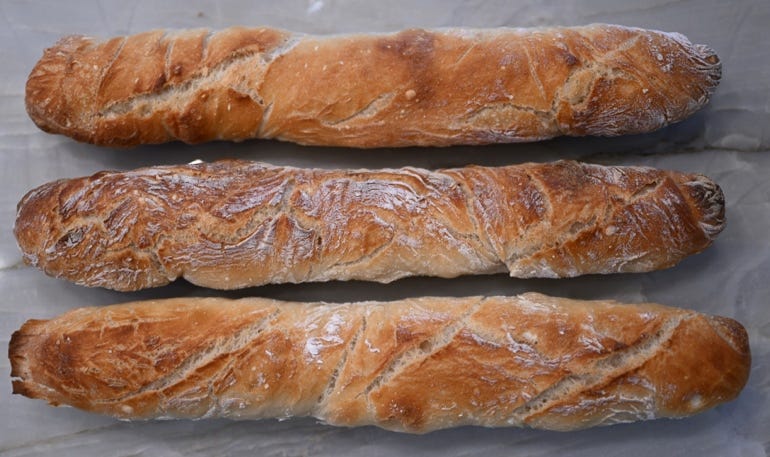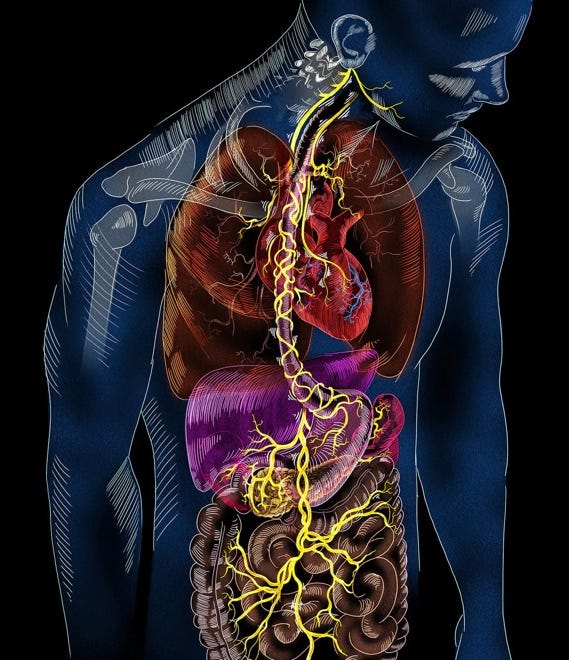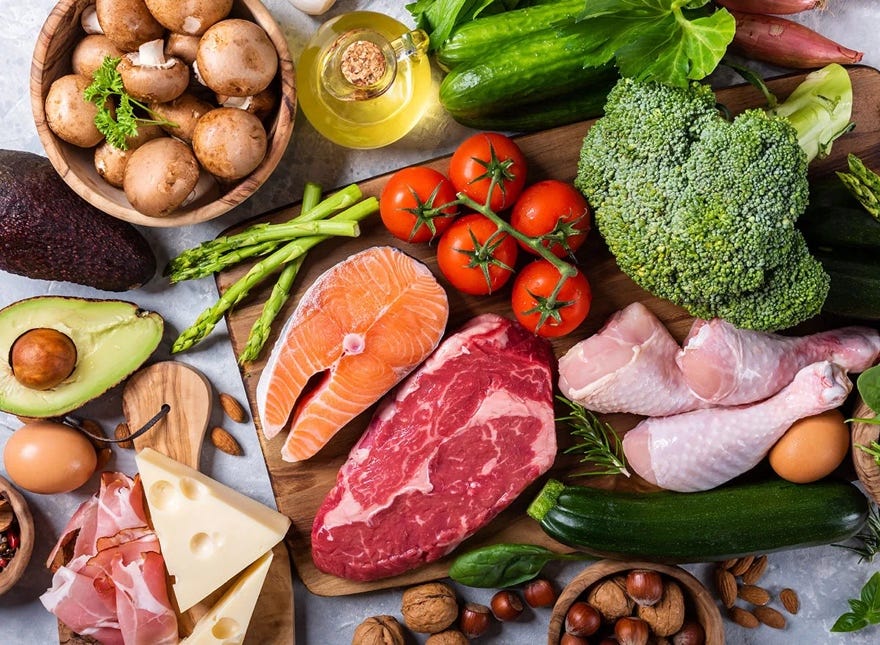I am addicted to French baguettes, plain, sourdough, mixed grain; you name it. Not the “French” baguettes you can buy at the grocery store or even the ones that come from the boulangerie down the street that advertises “real” French baguettes. We spent some time in France and most every morning enjoyed locally baked baguettes; crisp crunchy crust and light, airy crumb. Upon returning to the US I went in search of comparable baguettes. I knew that here they would not be the same, and I was willing to accept “close.” Almost needless to say, I didn’t find any. Now what? Move to France?
It came to me one night, “I’ll learn to bake my own baguettes like the ones I enjoyed in France.” Whereupon I launched: I took artisan bread baking classes; I outfitted our kitchen with all of the right utensils, including the appropriatele moules à baguette(ceramic bread bakers) from Emile Henry manufactured in Burgundy; I ordered French flour online. Over time I have learned to bake baguettes I consider acceptable, close enough to my desires (my family and friends agree most heartedly!). Of course, a trip to France would be delightful.
There is something ethereal, mystical, magical and satisfying about kneading dough for baguettes. Dumping the dough onto the table, my hands grasp the shaggy, moist dough, pull it towards me, and then fold it over. Pick up the dough mass, rotate ninety degrees, set it down, grasp again and pull the dough towards me, fold it over. Again and again as I watch the shagginess smooth out until, somehow my eyes and hands know it’s enough kneading. Back into the bowl for the dough to rise.
What transforms this gooey mass into the baguettes I love. The magic is in the gluten. What is gluten? “Gluten is a protein naturally found in some grains including wheat, barley, and rye. It acts like a binder, holding food together and adding a “stretchy” quality - think of a pizza maker tossing and stretching out a ball of dough. Without gluten, the dough would rip easily.” “Gluten: A Benefit or Harm to the Body?” The Nutrition Source, Harvard T.H. Chan School of Public Health. https://www.hsph.harvard.edu/nutritionsource/gluten/
Unfortunately, not is all good with gluten, much to my chagrin.
“Gluten is our generation’s tobacco,” says Dr. David Perlmutter in Grain Brain (Revised Ed., Little, Brown Spark, 2013, 2018), p. 75. Wow, that’s a hell of a statement with very significant import. “Gluten is one of the main causes of inflammation in the human body. … Gluten is a modern poison.”
Unfortunately, we are still living in a construed mythical world in which dietary fat and high cholesterol are considered prime drivers of disease, despite volumes of unassailable evidence to the contrary. “ … the shift in our diet that has occurred over the past century – from high-fat, low-carb to today’s low-fat, high-carb diet, consisting primarily of refined grains and other damaging carbohydrates – is the origin of many of our modern scourges linked to the brain …” Ibid., pp. 13-14.
The cornerstone of all degenerative conditions, including brain disorders such as depression, dementia, Parkinson’s, and Alzheimer’s, is inflammation. Gluten and a high-carbohydrate diet are among the most prominent stimulators of inflammatory pathways that reach the brain.
Gluten is found in grains, and comprises two main groups of proteins, glutenins and gliadins. Analogous to sucrose wherein fructose is the villain, here gliadins are the villains of gluten. Gluten sensitivity is caused by elevated levels of antibodies acting against the gliadin component of gluten.
Heretofore, gluten sensitivity has typically been discussed only in the context of celiac disease. “Celiac disease is a serious autoimmune disease that occurs in genetically predisposed people where the ingestion of gluten leads to damage in the small intestine. … When people with celiac disease eat gluten …, their body mounts an immune response that attacks the small intestine. These attacks lead to damage on the villi, small fingerlike projections that line the small intestine, that promote nutrient absorption. When the villi get damaged, nutrients cannot be absorbed properly into the body.” https://celiac.org/about-celiac-disease/what-is-celiac-disease/
About 2 million people in the United States have celiac disease, including a dear friend of mine. Worldwide about 1 percent of the population have celiac disease. R. Choung, et al., “Less hidden celiac disease but increased gluten avoidance without a diagnosis in the United States: findings from the National Health and Nutrition Examination Surveys from 2009 to 2014,” Mayo Clinic Proceedings 92(1):30-38 (December 22, 2016). https://doi.org/10.1016/j.mayocp.2016.10.012; Lebwohl, B., D. Sanders, and P. Green, “Coeliac disease,” Lancet 391(10115):70–81 (January 6, 2018). https://doi.org/10.1016/S0140-6736(17)31796-8
But what about the rest of us not afflicted by celiac disease? Modern research has demonstrated that, “all humans have some degree of gluten sensitivity.” It is referred to as non-celiac gluten sensitivity (NCGS). S. Drago, et al., “Gliadin, Zonulin and Gut Permeability: Effects on Celiac and Non-celiac Intestinal Mucoa and Intestinal cell Lines,” Scand. J. Gastroenterol. 41(4):408-19 (April 2006). https://doi.org/10.1080/00365520500235334
And, gluten sensitivity always affects the brain. R. Ford, “The Gluten Syndrome: A Neurological Disease,” Med. Hypotheses, 73(3):438-49 (September 2009). https://doi.org/10.1016/j.mehy.2009.03.037
Some people report that while they experience gluten sensitivity in the US, they do not demonstrate similar sensitivity eating bread and pasta in Europe. The difference is attributed to differences in the type of wheat and how it is grown. A major factor is European wheat is not sprayed with as many pesticides as that grown in the US. Another factor is many European bread recipes include buttermilk, the lactose in which helps break down gluten protein. E. Sweeney, “‘I Can’t Tolerate Gluten In The U.S., But I Can in Europe’: Experts Unpack The Phenomenon,” Huffington Post (October 25, 2022). https://www.huffpost.com/entry/eat-gluten-europe-us_l_63514ef1e4b04cf8f380beda; “French Bread: the Difference with Gluten in Europe vs US,” Natty Style (May 21,2019). https://www.nattystyle.com/natty-style/2019/3/26/french-bread-amp-why-you-might-be-able-to-eat-it-gluten-amp-all
The vegas nerve runs the entire length of your body from your brain to your gut. It is a two-way communication freeway. Your brain has about 100 million neurons; your gut has about 500 million neurons, and is commonly referred to as your “second brain.” Which brain “talks” the longest and the loudest? Does it matter?
S. Herculano-Houzel, “The human brain in numbers: a linearly scaled-up primate brain,” Front. Hum. Neurosci.3:31 (November 9, 2009). https://doi.org/10.3389/neuro.09.031.2009; E. Mayer, “Gut feelings: the emerging biology of gut-brain communication,” Front. Hum. Neurosci. 12(8):453-66 (July 13, 2011). https://doi.org/10.1038/nrn3071; S. Breit, et al., "Vagus Nerve as Modulator of the Brain-Gut Axis in Psychiatric and Inflammatory Disorders,” Front Psychiatry 9:44 (Mar 13, 2018). https://doi.org/10.3389/fpsyt.2018.00044; B. Bonaz, T. Bazin, and S. Pellissier, “The Vagus Nerve at the Interface of the Microbiota-Gut-Brain Axis,” Front Neurosci. 12:49 (Feb 7, 2018). https://doi.org/10.3389/fnins.2018.00049
It is well recognized that what’s going on in your mind can affect your gut. You feel anxious or stressed out or have a headache or …, and you get an “upset stomach,” more likely an “upset gut.” Going the upward direction, you irritate your gut … too much alcohol, spicy foods for some people, medication, especially antibiotics …, and your brain reacts; you feel dull, get a headache, etc.
The lining of your gut is semi-permeable; it is designed to allow water and nutrients to pass from your intestines into your bloodstream. It is also acts as a barrier to keep bad stuff out of your bloodstream and your body. Unfortunately, some people have increased intestinal permeability, a “leaky gut,” that allows larger molecules to pass into the bloodstream including potentially toxic ones. Permeability of the gut is a fundamental mechanism for increasing inflammation, which we know is a fundamental cause of brain disorders.
Getting back to gluten, gliadin is associated with increased gut permeability in all humans. In other words, even if you have not been diagnosed with “leaky gut syndrome” and do not necessary evidence any effects, if you eat foods containing gluten you are affecting the permeability of your gut and contributing to inflammation in your body. J. Hollon,et al., “Effect of gliadin on permeability of intestinal biopsy explants from celiac disease patients and patients with non-celiac gluten sensitivity’”Nutrients7(3):1565-76 (2015). https://doi.org/10.3390/nu7031565
Ok, you have told me that gluten is bad, but what foods should I avoid? Unfortunately, a lot of what we are used to eating, and have been told for years is good for us, is exactly what we should not be eating?
Take a deep breath before reading this list extracted from the Celiac Foundation Website … pastas, including raviolis, dumplings, couscous, and gnocchi; noodles, ramen, udon, soba (those made with only a percentage of buckwheat flour), chow mein, and egg noodles (rice noodles and mung bean noodles are gluten free); breads (my downfall category) and pastries: croissants (I make killer croissants!), pita, naan, bagels, flatbreads, cornbread, potato bread, muffins, donuts, rolls; crackers: pretzels, goldfish, graham crackers; baked goods: cakes, cookies, pie crusts, brownies; cereal and granola: corn flakes and rice puffs often contain malt extract or flavoring, granola is often made with regular oats, not gluten-free oats; breakfast foods: pancakes, waffles, French toast, crepes, and biscuits; breading and coating mixes: panko breadcrumbs; croutons: stuffings and dressings including packaged salad dressings, even the organic ones (there goes a big chunk of Thanksgiving); sauces and gravies that use wheat flour as a thickener (biscuits and gravy both gone, a two-fer), traditional soy sauce, cream sauces made with a roux; flour tortillas (for some of us corn tortillas just don’t do it); beer (skier alert), unless explicitly gluten-free, and any malt beverages; Brewer’s Yeast; anything else that uses “wheat flour” as an ingredient. Did they leave anything out?
If that list is not enough, research also shows that processed carbohydrates, sugar, especially high fructose corn syrup (HFCS), and starch contribute to inflammation. This eliminates Bar-B-Q sauce; chips (all of them); candy; energy bars and energy drinks; ice cream, frozen yogurt, and sherbet; jams, jellies and preserves; ketchup (the fries go too); potatoes, sweet potatoes and yams; processed cheese spreads such Cheeze Whiz (authentic Philly cheese steaks gone); juices; dried fruit; sports drinks; soda and soft drinks (probably the single worst category of bad); honey; agave; all forms of sugar, white, brown or specialty like demerara or muscovado; corn syrup; and maple syrup. We have now emptied most shopping carts and pantries, as well as eliminated most of what is called the “Western diet.”
J. Bruun, et al., “Consumption of sucrose-sweetened soft drinks increases plasma levels of uric acid in overweight and obese subjects: a 6-month randomised controlled trial,“ Eur. J. Clin. Nutr. 69(8):949-53 (August 2015). https://doi.org/10.1038/ejcn.2015.95; Y. Jiang, et al., “A Sucrose-Enriched Diet Promotes Tumorigenesis in Mammary Gland in Part through the 12-Lipoxygenase Pathway,” Cancer Res. 1;76(1):24-9 (January 2016). https://doi.org/10.1158/0008-5472.CAN-14-3432
“On August 2, 2013, the US Food and Drug Administration (FDA) announced its long-awaited gluten-free food labeling rule. According to the rule, when a manufacturer chooses to put “gluten-free” on food packaging, the item must comply with the new FDA definition of the term – less than 20 parts per million (ppm) of gluten. Manufacturers were encouraged to comply with the rule immediately, but had until August 5th, 2014. There is no requirement that gluten-free foods must be labeled “gluten-free.” Any food product conforming to the standard may be labeled “gluten-free” even if it is naturally gluten-free (i.e., water or fresh produce).” https://celiac.org/about-the-foundation/featured-news/2014/08/fda-gluten-free-food-labeling-information-page/
The FDA rule notwithstanding, you do have to be vigilant in the grocery store. A lot of “gluten-free” packaged foods have been processed to remove the gluten but are filled with other sources of inflammation. Typically gluten is replaced by cornstarch, cornmeal, rice starch, potato starch, or tapioca starch, all of which contribute to raising blood sugar levels. Also, check the list above.
I can hear teeth gnashing, stomachs growling, and the wailing … you’ve taken away almost everything; there’s nothing left to eat.
In reality, all is not lost; sometimes just major changes are required. Eat healthy fats like extra virgin olive oil, coconut oil, butter and cheese from 100 percent pasture raised cows, avocados, most nuts and seeds. Whole eggs (pasture raised are best), wild fish (salmon, trout, black cod, sardines, and the like); shellfish and mollusks (shrimp, crab, lobster, mussels, clams and oysters, not farm-raised); 100 percent grass-fed and grass-finished meat, fowl, poultry and pork; wild game. Leafy green vegetables and lettuce, broccoli, cabbage, onions, mushrooms, peppers, cucumber, cauliflower, Brussel sprouts, artichoke, green beans, celery, bok choy, radishes, turnips, asparagus, garlic, leeks, fennel, shallots, scallions, water chestnuts. Spices, herbs and seasonings like mustard and horseradish. Non-gluten grains such as buckwheat and rice. You get the drift … fresh, organic, local, unprocessed, and non-GMO.
Some people believe ancient grains such as einkorn, emmer, spelt and Khorasan have less or less impactful gluten than modern wheat. Modern wheat has less protein and more starch than these ancient grains, but ancient grains actually have more gluten than modern wheats. F. Brouns, et al., “Do ancient wheats contain less gluten than modern bread wheat, in favour of better health?” Nutr. Bull. 47(2):157-167 (June 2022). https://doi.org/10.1111/nbu.12551
Sorry, wheat still has to go.
If you make these changes, for some people your meals start to look a lot different, for others not so much. Bring on the bacon and eggs for breakfast, hold the bagel; or how about an omelet with onions, peppers, or spinach, with cheese. Make your own yogurt with whole milk from 100 percent grass-fed cows, and have it with berries or nuts. Salads with lots of greens and vegetables, hold the packaged dressing (it’s really easy to make your own salad dressing) are great for lunch. Dinners comprise quality protein with organic vegetables. Raw nuts, chopped raw vegetables, cheese, hummus, or slices of quality meats with mustard are great snacks; how about some fermented vegetables like sauerkraut, carrots, or beets.
You do get treats in moderation … dark chocolate (at least 70 percent cacao, and look for the lowest added sugar) and red wine (a glass or two).
Taking a step back, these lists of don’ts and do’s look suspiciously like a Mediterranean diet, which, of course, it is minus the gluten.
Save your gut and save your brain … take gluten out of your diet, or at a minimum work to reduce it.









playfully written - thank you